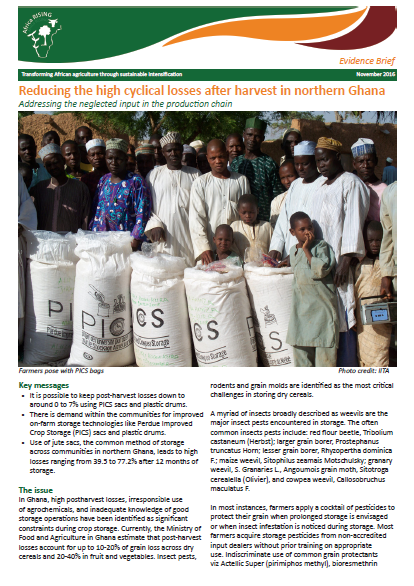Reducing high cyclical losses after harvest in northern Ghana
 In Ghana, high post-harvest losses, irresponsible use of agrochemicals, and inadequate knowledge of good storage operations are significant constraints during crop storage.
In Ghana, high post-harvest losses, irresponsible use of agrochemicals, and inadequate knowledge of good storage operations are significant constraints during crop storage.
Currently, the Ministry of Food and Agriculture in Ghana estimates that post-harvest losses account for up to 10-20% of grain loss across dry cereals and 20-40% in fruit and vegetables. Insect pests, rodents and grain molds are the most critical challenges in storing dry cereals.
A myriad of insects, broadly described as weevils, are the major insect pests encountered in storage. The common insects pests include: red flour beetle, Tribolium castaneum (Herbst); larger grain borer, Prostephanus truncatus (Horn); lesser grain borer, Rhyzopertha dominica F.; maize weevil, Sitophilus zeamais (Motschulsky); granary weevil, S. Granaries L., Angoumois grain moth, Sitotroga cerealella (Olivier), and cowpea weevil, Callosobruchus maculatus F.
In most instances, farmers apply a cocktail of pesticides to protect their grain when prolonged storage is envisaged or when insect infestation is noticed during storage. Most farmers acquire storage pesticides from non-accredited input dealers without prior training on appropriate use. Indiscriminate use of common grain protectants viz Actellic Super (pirimiphos methyl), bioresmethrin (pyrethroid), Campha, Wonder 55, and phostoxin (aluminum phosphate) is widely reported.
Africa RISING designed experiments and trainings to address some of these knowledge and technical gaps to manage harvest surpluses. We provided information and demonstrations on integrated pest management and good storage operations to reduce on-farm storage losses. We specifically:
- Scaled out improved technologies to manage major insect pests during prolonged storage of dry cereal grains and pulses.
- Trained farmers, farmer-based organizations and agricultural extension agents on proper post-harvest practices for dry cereal grains and pulses.




